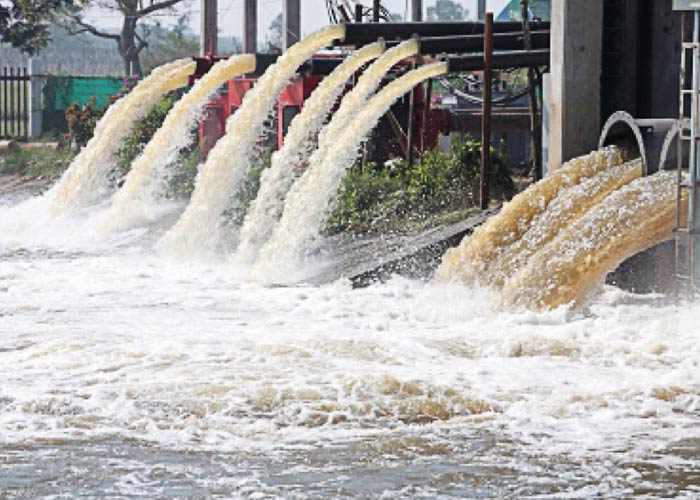The world has been facing the problem of waste disposal and the rapid industrial and technological development has only accentuated it. The increasing variety of waste has become one of the biggest challenges pertaining to environmental protection.
In olden times, waste generated was generally organic in nature which would dissolve into the ground, but alongside modern development, the proportion of hazardous substances in the garbage has increased manifold. It poses grave threat to humans, animals and plants.
Earlier bags used to be made of harmless substances like cloth and jute. Pottery was used to carry things like milk, tea or curd. The plastic has changed the situation for the worse because the plastic never degrades. Its recycling is possible, but there is generally a lack of safe, quality and proper management for plastic disposal.
In India, the problem of waste disposal can be witnessed everywhere; from overflowing garbage to improper disposal of e-waste this is a very serious issue which needs to be recognized and tackled on a war footing. Improper drainage system, mountains of garbage, urinating in public, throwing waste on the streets, etc are all very usual sights in our country. Therefore, we need to develop effective methods of disposal of waste to sustain life and conserve environment.
Meaning of Waste Disposal
Waste disposal implies removal, destruction or storing of damaged, used or other unwanted domestic, agricultural or industrial products. Burning, burial at landfill sites or sea, and recycling are part of the waste disposal process.
Broadly speaking, waste disposal involves collection, transportation, dumping, recycling, sewage treatment along with monitoring and regulation measures for waste products. In the course of these various processes, there are a lot of problems that tend to get associated with waste disposal.
Problems due to Improper Waste Disposal
- Excessive Quantity – The world witnesses huge generation of waste on a regular basis. About 220 million tonnes of waste is produced annually in the United States alone. We can imagine how much waste might be produced globally.
According to a World Bank report, the average global municipal solid waste (MSW) generation per person on daily basis is about 1.2 kg and the figure is expected to rise up to 1.5 kg by 2025. Effective waste disposal is a major requirement of every state and local authority. Without prioritizing on reuse, recycling or the use of environmentally friendly materials, a number of one-time use products are produced globally, leading to increase in the amount of waste generated.
- Toxic nature of waste – The ever-expanding manufacturing industries produce very hazardous toxic products that end up getting thrown away after use. For example, packaging is one of the biggest and rapidly enlarging categories of solid waste in which approximately 40% of the waste is plastic which is not biodegradable.
- Mess at landfills – Lack of proper on-site waste management of landfills contributes to serious threats to the environment. In the long-term, landfills leak and pollute ground water and other neighboring environmental habitats, making waste management very difficult. They also emit potentially unsafe gases.
- Prevalence of vested interests – Waste disposal and management has become a lucrative business. All aspects of the market from operating landfills, sewer systems and incinerators to recycling facilities are dictated by the large enterprises that operate in the waste disposal business. The aim of such businesses is simply to make profits regardless of the waste reduction requirements or the resultant destructive impacts on environment.
- Outdated waste disposal technologies – Instead of developing effective recycling and waste reduction programmes, short-term solutions are relied upon for waste disposal and management facilities. As a result, outdated technologies are used to deal with waste disposal. Lack of novel technologies for reducing the toxicity and volume of waste or enhancing recycling, especially of solid waste is a major issue. Some of the technologies that are marked as “green” are not so in the true sense.
Types of Waste
1. Liquid Waste – This type of waste is generally found both in households as well as in industries. Dirty water, organic liquids, wash water, waste detergents and even rainwater are certain types of such waste. Liquid waste can be classified into point and non-point source waste. Point source waste is all the manufactured liquid waste. Natural liquid waste is classified as non-point source waste.
2. Solid Waste – This type of rubbish includes a variety of items found in your household along with commercial and industrial locations. Solid waste has the following types:
- Plastic waste: Many products that can be found in our household such as bags, jars, etc. come under this category. Many types of plastic can be recycled though it is non-biodegradable. Plastic should be sorted and placed in the recycling bin.
- Paper/card waste: Packaging materials, newspapers, cardboards and other products are included in this category of waste.
- Tins and metals: Various items such as metals that exist in our households come under this category.
- Ceramics and glass: These are easily recyclable items.
3. Organic Waste – This type of common household waste includes all food waste, garden waste, manure and rotten meat. Organic waste is turned into manure by microorganisms over time but this does not mean that it can be disposed anywhere. It must never be simply discarded with general waste as it causes the production of methane in landfills.
4. Recyclable Waste – All waste items that can be converted into products to be used again are the ones that come under this category. Paper, metals, furniture and organic waste are the type of waste that can be recycled.
5. Hazardous Waste – All flammable, toxic, corrosive and reactive waste come under this category. These items can cause harm to the environment as well as to the people and so must be disposed off carefully.
Methods of Waste Disposal
- Landfill – The waste that cannot be reused or recycled is spread out in a landfill in some low-lying areas across the city. After each layer of garbage, a layer of soil is added. After this process, the area is declared unfit for construction for next 20 years. This area can only be used as a playground or park.
- Incineration -The process of controlled combustion of garbage to reduce it to incombustible matter (ash, waste gas, and heat) is called i The waste gasses generated in the process are treated and released into the environment. This process reduces the volume of waste by 90 percent. It is considered as one of the most hygienic methods of waste disposal. The heat generated is used to produce electric power in some cases.
- Waste Compaction –Waste materials such as cans and plastic bottles are compacted and made into blocks and are sent for recycling in the process. Transportation and positioning is made easy as this process prevents oxidation of metals and reduces air space need.
- Biogas Generation – Food items, animal waste or industrial waste from food packaging industries are sent to bio-degradation plants. These plants convert the waste to bio-gas by degradation with the help of bacteria, fungi, and other biological means. The micro-organisms use up the organic matter as food. The degradation can occur either aerobically (with oxygen) or anaerobically (without oxygen). Bio-gas generated as a result is used as fuel, and the residue is used as manure.
- Composting – Organic materials tend to decompose with time. Majority of wastes are made by food scraps, yard waste, etc. Nutrient rich manure is formed by organic materials which are buried under beds of soil and which decay under the action of microorganisms. This is the process of composting. This process increases the soil’s water retention capacity and enriches it.
- Vermicomposting – The process of using worms for the degradation of organic matter into nutrient-rich manure is known as vermicomposting. Organic matter is taken up by worms and they feed and digest it. Excretory materials or the by-products of digestion given out by worms makes the soil nutrient rich which enhances the growth of bacteria and fungi.
- Recycling – Wastes are transformed into products of their own genre using industrial processing and this process is known as recycling. Commonly recycled products include paper, glass, aluminium and plastics. This process allows us to reuse the items in an environmentally-friendly manner.
- Disposal in Ocean/Sea – Radioactive wastes are usually dumped into oceans away from human habitats but this is thought to deprive ocean of its inherent nutrients and also harm the aquatic life.
Waste Disposal Management/Solutions
Natural resources are decreasing. Raw material is becoming expensive and the cost of extracting it is also increasing. In this context, recycling metal like aluminum saves 95 percent energy and 60 percent of the time.
- Government Initiatives – In collaboration with NGOs in Indonesia, biological portion of waste is allowed to rot and the chemical part is separated from it. Help is sought from tourists too to avoid mindlessly piling of waste, and generate as far as possible organic waste, which has the potential for the development of urban mineral resources.
One advantage of such initiatives is that people become aware of waste as well as the difficulties in disposing it off. Teens are taught that they should try to reduce garbage and avoid chemical waste.
The Government of India has launched Swachh Bharat Abhiyan (SBA) and Smart City Mission (SCM) to improve standards of sanitation, hygiene and living across the country. In preparing a three-year work agenda (2017-18 to 2019-20), the Niti Aayog has prepared a comprehensive framework to tackle the problem of Municipal Solid Waste (MSW).
As per the 2011 Census, 77 million residents living in 7,935 urban areas, generated 170,000 tonnes of solid waste per year in India. In view of this fact, the Aayog has been developing the agenda to complete the work in time, because by 2030, due to the expansion of cities boundaries, 590 million inhabitants would be living in cities, making management of waste all the more difficult.
The solutions suggested in this agenda are of two types: Generation of energy from waste material for large municipalities and disposal of waste for small towns and semi-urban areas by setting up a plant. In it, it has been suggested to set up a new Waste to Energy Corporation of India (WECI) under the public-private partnership model. After the establishment, the proposed corporation will play an important role in the generation of energy from waste in 100 smart cities by 2019.
The government should be given credit for starting discussion on this social and environmental problem. The agenda proposed by the Niti Aayog to make the country clean and green is a step in the direction of proper waste management.
- 3 R’s – Management of waste and movement in the right direction to achieve zero waste can be achieved with the implementation and consistent practice of the three R’s mantra of Re-use, Reduce, and Recycle. More efforts should be put towards the education of waste management by local communities, authorities and states. Proper segregation of waste, awareness regarding proper disposal and making people practice 3 R’s can help us tackle the waste disposal issue.
- Effective waste disposal and management – Improved solutions for various problems associated with waste materials can be offered by an effective strategy for municipal waste disposal and management. Gradual improvement of new and cost-effective facilities which aim to encourage higher environmental protection standards is an essential part of this strategy.
- Controlled and Monitored Land filling activities – Various local construction industries generate tonnes of construction and demolition materials. Construction and demolition materials can be resourcefully reclaimed, reused or recycled in other projects such as landscaping, village houses, recreation facilities or car parks, or roads with the control and monitoring of land filling and fly-tipping activities in the area of public works.
- Hygienic and efficient waste disposal management –Solution to waste problems can be offered by a multifaceted approach on waste transfer and diversion in terms of more hygienic and efficient waste disposal management. The local authorities and state waste management facilities need to formulate waste disposal plans, with an objective of making certain that there is convenient and proper waste disposal at landfills and waste transfer facilities to address most of the waste problems. Mandating equipment standards and rerouting of refuse collection/transfer are measures that can enhance the environmental performance of waste disposal operations.
- Thermal waste treatment – It has been proved that thermal waste treatments are not 100% green as they are usually said to be. States researchers as well as green groups and academicians can explore the possible developments regarding advanced thermal waste treatment techniques. For dealing with the environmental concerns, appropriate and improved thermal waste treatment technology is a significant strategy.
- Extra charges for polluters – Polluters who generate waste need to pay for the suitable disposal of non-reclaimable materials when it comes to waste management. Law requires the polluter to pay for the impact caused to the environment. Charging schemes should be incorporated on all waste disposal aspects including construction waste and domestic waste through public fill reception facilities for the pay principle to be effective. It is part of Eco-product responsibility policy, which is a great tool for waste reduction, recovery and recycling. Producers, wholesalers, importers and retailers are required to share responsibility for the collection, treatment, disposal and recycling of used products with an aim of cutting back and steering clear of the environmental impacts caused by such products.
Importance of Waste Disposal
- Public Health Preservation – It’s important for proprietors to remove potentially dangerous chemicals as environmental waste has a significant impact on public health. For example; due to the presence of dangerous elements in dead car batteries, they should be disposed very carefully.
- Economic Advantages – Employment of proper waste removal system provides a lot of societal economic benefits. For example, ensuring that a product is used as a part of an area (garden or local farm) for compost can help replenish nutrients in the ground and help municipalities save money on landfill areas.
- Environmental Protection – Improper disposal of a plastic product or one containing dangerous chemicals can help the waste make its way into local water sources and soil, thus affecting local wildlife as well as natural growth processes. Apart from NGOs, governments are also engaged in the protection of wildlife across the world. Special efforts are also being made to save the living organisms facing extinction due to improper methods of waste disposal.
- Saving Energy – Organizations can benefit from usage of proper waste management and waste disposal strategies. Significant amount of resources is spent on incineration systems by these organizations which use up energy without providing any significant gain. Technologies which help capture energy used by these incinerators have been crafted which allow cities to generate electricity through the process of incineration.
- Climate Change – Due to the improper disposal of waste, greenhouse gases have seen a significant increase. These trap a lot of heat which harm all living organisms.
Conclusion
Faulty waste disposal gives rise to a number or issues or problems which can ultimately cause harm to the Planet Earth. By following simple techniques such as the 3 R’s can help us bring a significant decrease in the waste produced and also help us dispose it properly. Employing various waste disposal methods, management techniques and solutions can help us bring a significant decrease in the number of problems that are caused globally due to improper waste disposal.







